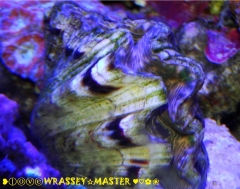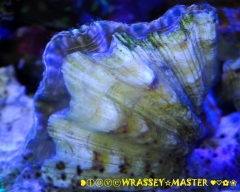Search the Community
Showing results for tags 'Hippopus Clam'.
-

Hippopus Clam - Aquacultured aka Hippopus hippopus
kueytoc posted a gallery image in Members Gallery
From the album: WRASSEYMASTER® Reef Paradise
Aquarium Invertebrates: A Look at the Hippopus Clams By James W. Fatherree, M.Sc. http://www.advancedaquarist.com/2010/3/inverts -

Hippopus Clam - Aquacultured aka Hippopus hippopus
kueytoc posted a gallery image in Members Gallery
From the album: WRASSEYMASTER® Reef Paradise
QUICK STATS Care Level: Moderate Reef Compatible: Yes Lighting: High Waterflow: Low to Medium Placement: Bottom to Middle Water Conditions: 72-78° F, dKH 8-12, pH 8.1-8.4, sg 1.023-1.025 Color Form: Black, Tan, Yellow Diet: Filter Feeder Supplements: Calcium, Magnesium, Strontium, Trace Elements Origin: Aquacultured - USA Family: Tridacnida The Hippopus clam is also known as Horse's Hoof, Bear Paw or Strawberry Clam. The shell of this clam is very thick with prominent ribs, and has reddish blotches making it easy to differentiate from other clams. The mantle of these clams does not extend past the edge of the shell, and are brownish-green to gray in color with faint gold stripes. The large opening in the mantle, which is called the incurrent aperture, lacks the tentacles that are common with other clams within the Tridacnidae family. These are relatively fast growing clams that process a lot of water for their size which helps in controlling nutrients in a reef aquarium. A well-established reef aquarium with moderately high lighting is ideal for the Hippopus Clam. These clams prefer to be seated in the substrate with a low to moderate water current. As they grow, they will eventually loose their byssal gland, and will rely on their weight to keep them in place. It is ideal to place these clams on a flat rock that is buried in the substrate to keep access to the byssal opening away from any potential predators. The Hippopus Clam requires calcium levels of at least 280 mg/L, preferably 380-440 mg/L, as well as adequate strontium and iodine. They require moderately high lighting from which they receive part of their required nutrition. They also need nutrients within the water in which they can feed. Provide phytoplankton in the form of a filter feeding food, weekly. They also feed upon ammonia and nitrates within the aquarium, and are a good addition to the reef aquarium for helping control these nutrients.


